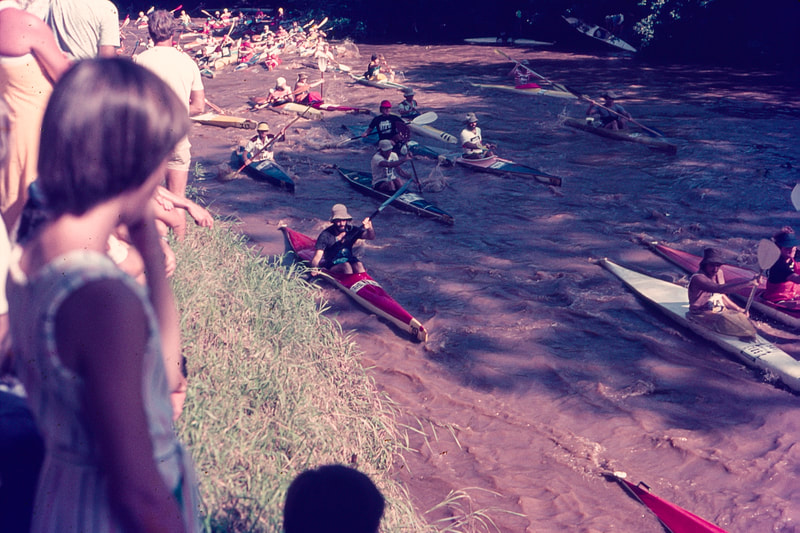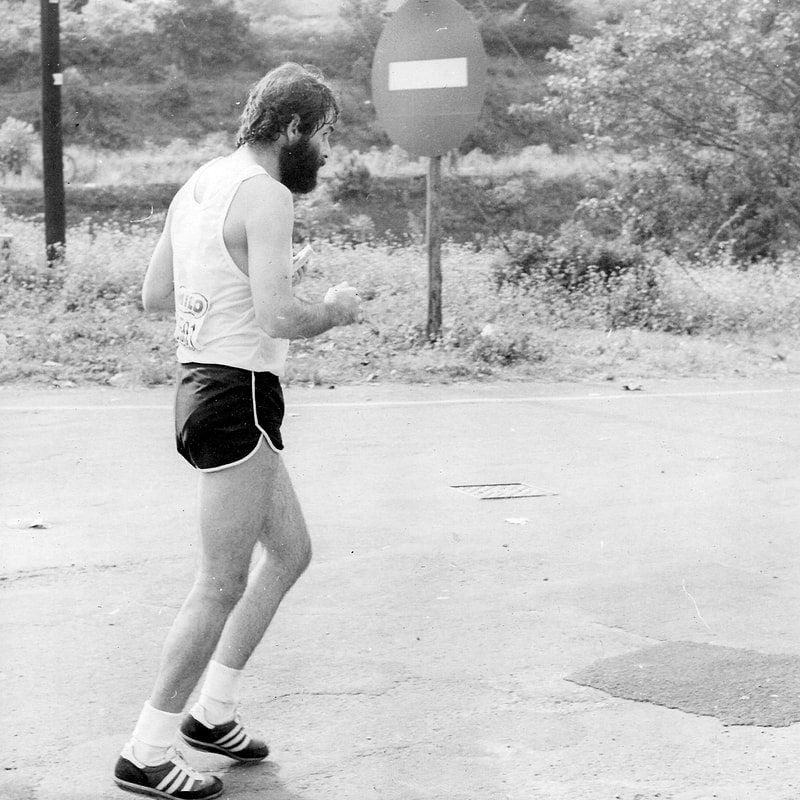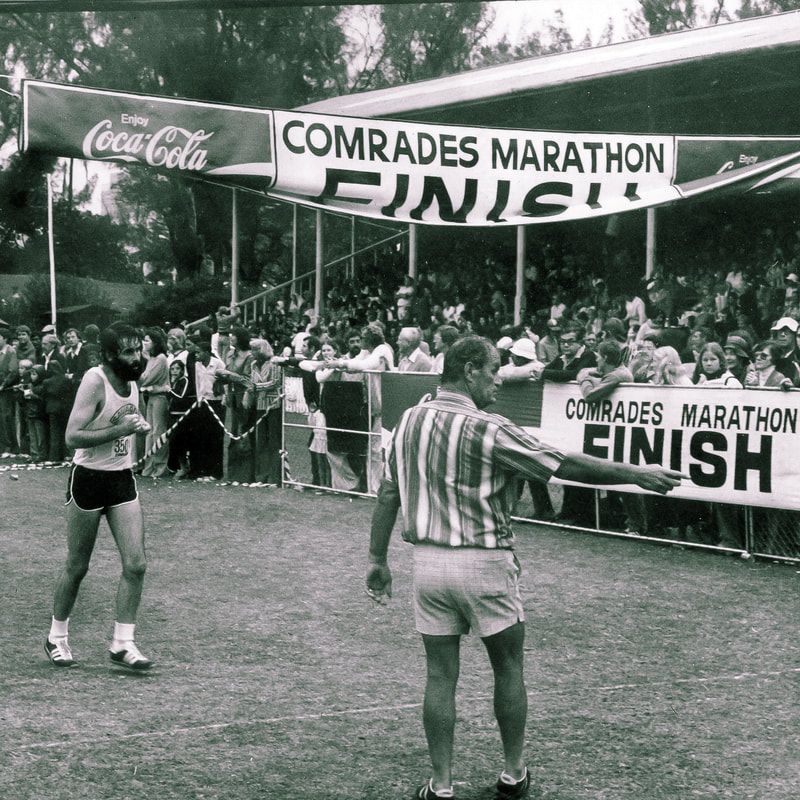|
*Fuzzy Photos and Unreliable Tasting Notes In the picture below are, from left to right, Russell Kay, me, Liz Clarke enjoying a Castle, the backs of some heads, me again and Garnet (Groper) Currie I can't pretend that returning to life in the newsroom after a year's dream assignment in London wasn't an anticlimax. But life had to be grabbed and I'd signed up to 3 years back at the Daily News so I needed to make the best of it. The most enjoyable part was reacquainting myself with old friends, although time with Garnet (on the extreme right above) was going to be short as he was heading to London on a similar expedition. It would've been stonking if we'd overlapped in the UK but it wasn't to be ... besides, as a married man, I would probably have cramped the style of the legendary Groper[1] Currie. My compensation was that, in those days, it was considered normal for blokes to write letters to each other, so I was able to live vicariously through my mate's purple prose. Carmela was delighted to be able to spend time with her family again and we moved from London into a flat in Montpelier (sic) Road just a few 100 metres up the road from the Toscano family. South Africa had finally acquired television while we'd been away and our families had been hopefully watching the test pattern on recently bought TV sets. When some proper content eventually materialised, much of it was viewing repeats of stuff like Little House on the Prairie (LHotP). Much of this was translated into Afrikaans while a homegrown market for content developed. Sometimes the translation didn't quite deliver the je ne sais quoi the editors had hoped for. LHotP translated as "Kleinhuisie op die Veld", which, when translated back again, resulted in "shithouse in the grassland". And then there was The World at War (TWaW). This was a superb documentary built around World War 2 and narrated by Lawrence Olivier. It may be difficult to relate to the immediacy of this series now that it is 2023 and the events unfolded in the mid 1940s, but in the mid 1970s many, my Dad included, had been scarred by what still seemed like a recent conflict. Our family gathered religiously around my parents' TV set on the nights each instalment went out. It was really the only TV I cared to watch in those months after our return. Against the backdrop of early SABC programming TWaW was "like bright metal on a sullen ground,[2]". Having been a bit of a TV addict in my temporary London home, I resolved to look elsewhere for other stimulation. Work was part of it (and will form the basis of the follow-up blog to this one) but, after a sloth-like existence in the UK, I approached sport, including some new ones, with a renewed vigour. I'm not sure of the exact chronology but Carmela and I were spending a fair bit of time with her sister, Elena, (who had visited us in the UK) and Elena's beau, Howard Frizelle, who was to become her life's partner. So I am pretty sure the new sports bug started with kayaking. Bring on the Kayaks First of all I think, Howard had invited me to take part as his doubles (K2) partner in an event on the Mzimkulu River. At the last minute he made an arrangement with his brother, Mike, to do the race in Mike's own K2. Howard was apologetic and proposed that my old mate, Andrew Hathorn, be persuaded to accompany me in Howard's boat. The Mzimkulu was a novice event, he reassured us. Andrew has never been a fearful sort and was undeterred when a long journey to the foothills of the Drakensberg proved that there was more water in the river than was customary. Perhaps it was in spate? The bottom line was that we entered the first proper rapid at the top of the white water and half a boat and two separate paddlers left the river at three different points. I couldn't find Andrew and feared the worst. I lost him for what seemed an eternity. Eventually I heard shouting from the top of a hill quite a bit further downstream and our race concluded with a long walk to the finish. Reasonable people might conclude that that would have put paid to my kayaking career. I paid for half a new boat for Howard and I think Howard accepted responsibility for the other half. The next week I spent the remainder of my savings on a used white water K1. Took it off Tony "Spikey Norman" Kinnear[3]. My first boat didn't last long ... ended up at the bottom of this very same rapid, Dog Leg near Durban, sometimes a trickle, other times a raging torrent. As children of Durban our main kayak event on the annual calendar was the Dusi Canoe Marathon, in those days held over three days. The start was in Pietermaritzburg, the provincial capital of what is now KwaZulu-Natal, and the finish was (and still is) in Durban. Initially the Msundusi river snakes and writhes its way to the Umgeni, which ultimately flows into the Indian Ocean. My first go at the Dusi, in 1977, was once again a Frizelle/Harrison pairing. We acquitted ourselves pretty well, placing 51st. Although this was fairly impressive for a first go at the event, we narrowly missed the top 50 whose names were traditionally included in the following year's programme. If I remember correctly, Mike Frizelle and his partner finished 49th. The following year I paddled my own canoe, a shiny new K1. The river was pumping that year and I had a whale of a time. I was a tad unfit but I nailed the rapids and, once again, had a respectable finish. Respectable enough to have a go at that year's Seals Iron Man challenge, which consisted of finishing the Dusi, the Midmar Mile swim[4] and the Comrades Marathon. The "Comrades" as it was known (still is) followed the same route as the Dusi but took a more direct 90 km road route. Others may disagree but the Comrades is far more brutal than the Dusi, especially as the 90 km (more than two standard marathons back to back) has to be completed within 11 continuous hours. More of that a little later. Above: (top row, l to r) Howard looking a little pensive before an event; hotdogs are the order of the day for padkos (road food); Elena and Carmela (the intrepid photographer) are the support team; (bottom row, l to r) Setting off from Pietermaritzburg in 1978 somewhat tentatively - no need to capsize this early in the event; first overnight stop reached; portaging the canoe over "Burma Road", nearing Durban - the river below being considered too dangerous in big water in those days. For reasons that I can no longer recall, I swapped my beloved kayak for a surf ski. While they had tolerated my pootling around in canoes on rivers, Spikey and Groper never quite accepted that switch to a paddle ski for the sea. The only cool device on which to catch waves was a surfboard[5]. Above: Spikey can't even look at me extolling the virtues of paddle skis ... Groper looking, well, Groper. Swimming Not much to say about that really. Swimming had been a big part of my pre-teens, mainly because I had wanted to emulate my Dad, Woody, who had been selected to swim for South Africa in the 1944 Olympics. The 44 Olympics didn't happen for obvious reasons and Dad would've been part of South Africa Air Force 24 Bomber Squadron when he should have been swimming for his country. Above; I might have come 518th but there were thousands swimming and my Dad was proud of me ... And it was another brick in the wall for the 1978 Iron Man award. But there was another mountain to climb altogether. Running I'd done a bit of sprinting and cross country at school but the Comrades was an altogether sterner challenge. Training started in 1977 with the weekly 5 mile (8 km) time trial at our local club, Savages. My first few attempts at the 5-miler involved a fair amount of walking and each took just short of an hour. I was going to have to do a whole lot better than that. Probably have to take half that time. I did manage to corral Spikey into the whole enterprise, which was a small achievement in itself. We eventually set off to run an official 10-miler somewhere up the North Coast from Durban. The outcome was somewhat ignominious and we needed to up our game. We inveigled Groper as our coach, a rôle he approached with initial alacrity. Our next distance involved a 15-miler around Hillcrest[6]. The name said it all but we trotted off gamely with Groper waving us on with exaggerated pride. He was to head off along the route in his car and stop occasionally to ply us with water. For maybe 10 miles we were OK. We'd done that distance before and cantered along confidently. After a few more miles we ran into a brick wall. Groper had forged ahead in the car and set himself up at around the 13 mile mark. When we eventually arrived, to say he was crestfallen would have been the understatement of 1977. By that time we were last and second-to-last. Our coach alleged that the gap to the rest of the field was an extreme disappointment to him. We had to find a new support team. Wives, girlfriends and sundry blokes rose to the occasion. Each time we extended to a new distance our times were pretty dismal. Although we acquitted ourselves not too badly in our first standard marathon[7]. We had to do two in less than 4.5 hours to qualify for entry to the Comrades and had managed to achieve the time on our first go. We had become a bit complacent by our third or fourth "standard" and joined a large party of about 20 friends and colleagues at a local Greek restaurant for a meal that went on into the small (or maybe a bit more than small) hours the night before. Charles and Bonnie were our seconds and delivered us to the start at 6 am. This was Durban summer and races were run in the relative cool of the morning. Spikey and I had to pull over (not quite at the same time) pretty soon for epic bush poos. I think it was the first time we broke the 3.5 hour mark for a marathon. By the end of that day it transpired that we were the only ones from the previous night's party who had not ended up in Addington Hospital having stomachs pumped. Above: one of the great joys of working on Durban's Daily News was association with our world renowned cartoonist, Jock Leyden. I will always cherish the signed copy penned by Jock before the race. In the middle picture Jock has drawn the four Daily News Comrades entrants, Spikey and me at the rear and two of our more seasoned colleagues[8] out front. We also had a great photographic department and I was strong-armed to run across a golf course at sunrise for a pre-race publicity pic. There was one road race that bridged the gap between the standard marathons and the Comrades. It was the 35-mile Arthur Newton Road Race and incorporated most of the biggest hills the big race would traverse in a few weeks' time. In those days seconds were still permitted to follow their runners in a car. For this event Dad had decided to perform this role and take his 77-year-old mother along, too. My gran was sitting in the back seat behind him as we hit the meanest hill on the event. I was taking some strain as we were nearing the finish of a gruelling race. Dad decided to slow down so that I had to run past on the outside. As I crept past, he leant out of the driver's window and shouted: "Lift your knees up!" "Fuck off!" was my shouted retort. I think it was the first occasion I had used that phrase directly at my father but it was certainly breaking news as far as my gran was concerned. She had been gazing out of the rear window with benign grandmotherly love as the car took off up the hill, electric windows slamming shut and cresting the incline before I could manage more than a few extra steps. Not my finest hour but my Dad should've known better. The 1978 Comrades Marathon I can't say I remember too much about the main event but there were a few high/low lights. But first a few pictures from the earlier, fresher part of the 31st of May 1978. Above, l to r: there were two motorcycle teams supporting the Spikey-Banjo[1] duo ... this one consisted of my brother-in-law Deane MacEwan and colleague John van der Meer (the other was made up of Charles Phillips and, I think, Groper who may or may not have relented and seconded us for the main event); it might not look like it but I was still fresh at this point and receiving some encouragement from Deane; Spikey chatting with Charles with what looks like John on the bike behind. The religion we adopted for long-distance running in 1978 was to drink as much liquid as we could. This should be a 50:50 mix of water and a soft drink. For the first half of the race the soft drink should be cream soda and for the second half, Coca-Cola (Coke). The rationale for this was that Coke was deemed to be a bit of an "upper" and the effect would wear off and bring about depression if consumed early on. The soft drinks also provided the required glucose. "How do we know if we are drinking as much as we can?" we asked a pre-event expert lecturing on the dangers of heat exhaustion. "If you're not pee-ing regularly, you're not drinking enough," the expert commanded. "A dozen litres should about do it." Consequently we glugged our liquids diligently while we still had contact with our seconds before the start. During the time lapse between our support team melting away and the starting gun being fired the inevitable happened and there were several thousand runners heading away from the Town Hall desperately looking for a place to pee. Any hedge in a storm. This first hedge just happened to be outside the Grey's Hospital nurses home. The nurses were aware that this would happen and were on call to cheer and clap at the runners' relief. The first stretch out of Pietermaritzburg is long and straight and downhill and then long and straight and uphill. In amongst the twenty-somethings were quite a few more venerable fellows with green and gold numbers, being the badge of a serious veteran. "Ayup Grandad," we young 'uns would cheerfully greet our seniors, "see you in Durbs." The response was invariably a knowing nod. I can more or less guarantee that every one of those veterans had got to Durban, gone home, had a shower and were quaffing lager by the time I arrived. I had been pootling along quite nicely until I got to the end point of the Arthur Newton and the inevitable denouement hit my knee like a brick. The pain was ghastly but I managed to carry on for a few more miles until a helpful bystander pulled me over, shouting to his wife: "Bring me the magic potion, dear." She quickly complied, bearing a bog standard plastic bottle of brake fluid, the contents of which her husband proceeded to massage into my knee. I kid you not, it worked for a while, too. But the last 20 kms were agony. Durban was an eternity away. I finally managed to finish with 15 minutes to spare to beat the 11-hour milestone. Above: the deterioration is evident in my countenance as I neared the FINISH. I'm surprised there was still someone behind me in the second pic in the top row! I went to work the next day. There was a certain badge of pain to be relished, especially as I'd completed my 1978 Iron Man challenge. The pain was pretty extreme, though, and I was dragging my bad leg across an intersection, realising that I wasn't going to make it across before the lights changed. As I was nearing the centre of the road a woman in the same predicament approached from the other side. We stood there for a minute. "I know where you were yesterday," I smiled. She just grinned. That's one of the reasons it's called the Comrades. Coming up
That's enough of the sporty stuff. Except, I suppose, that my job became that of the Daily News's Morning Editor, so a fair bit of motorsport took place. [Endnotes]:
2 Comments
Andrew Hathorn
25/4/2023 12:21:42 pm
I still owe Howard for the other half of the canoe. I recall that the reason we hit the rock that broke it was because I didn't paddle hard enough for us to maintain speed relative to the speed of the river!
Reply
Leave a Reply. |
Mark Harrisonsee About tab for more detail about the author Archives
April 2024
Categories |



















 RSS Feed
RSS Feed